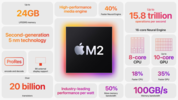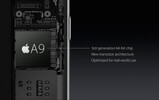Apple A9X vs Apple M2 vs Apple A9
Apple A9X
► remove from comparison
The Apple A9X is a high-end ARM SoC (System on a Chip) that was announced in September 2015 in the iPad Pro. Technical details are scarce, what we know is that it is based on the third generation of Apples 64 Bit architecture (Cyclone 3) and manufactured with a "new transistor technology" (14 or 16nm FINFet probably).
The performance of the A9X did improve a lot according to Apple. The CPU part should be 1.8x faster and the GPU part even 2x faster than the already speedy Apple A8X. Apple even stated in the keynote of the iPad Pro that the performance should be "faster than 80% of portable PCs shipped in the last 12 month". Furthermore the iPad Pro now features a 2x higher memory bandwidth (DDR4?) and 2x faster storage performance. The integrated graphics card will most likely be a PowerVR design again (Power VR Series7?).
Apple M2
► remove from comparison
The Apple M2 is a System on a Chip (SoC) from Apple that is found in the late 2022 MacBook Air and, MacBook Pro 13. It offers 8 cores divided in four performance cores and four power-efficiency cores. The big cores offer 192 KB instruction cache, 128 KB data cache, and 16 MB shared L2 cache (up from 12 MB). The four efficiency cores are a lot smaller and offer only 128 KB instruction cache, 64 KB data cache, and 4 MB shared cache. The efficiency cores (E cluster) clock with up to 2,4 GHz, the performance cores (P cluster) with up to 3,5 GHz and therefore higher than the M1 cores. The architecture should be similar to the A15 (iPhone 13) with Avalanche and Blizzard cores.
The chip features a unified memory architecture for the CPU and GPU cores and supports up to 24 GB LPDDR5-6400 for a bandwidth of up to 100GB/s.
According to Apple, the M2 offers a 18% higher CPU performance at the same power consumption level compared to the Apple M1. In our tests, the MacBook Pro 13 with active cooling was able to reach the 18% in Geekbench Multi. In other benchmarks we measured 12 to 15% gains compared to the M1. Therefore, the performance is now near the M1 Pro with 8 cores. The passively cooled MacBook Air may however suffer from throttling in longer load scenarios.
The integrated graphics card in the M2 offers 8 or 10 cores and a peak performance of 3.6 TFLOPs.
Furthermore, the SoC integrates a fast 16 core neural engine with a peak performance of 16 TOPS (for AI hardware acceleration), a secure enclave (e.g., for encryption), Thunderbolt / USB 4 controller, an ISP, and media de- and encoders.
The Apple M2 includes 20 billion transistors (up from the 16 billion of the M1) and is manufactured in the second generation 5nm process at TSMC (most likely N5P). The power consumption is rated at 20W what we also measured under CPU load.
Apple A9
► remove from comparison
The Apple A9 is a high-end dual-core ARM SoC for smartphones. It was announced in Sept. 2015 in the new iPhone 6s and 6s Plus. Technical details were not published, but the CPU part should be about 70% and the GPU 90% faster than the previous Apple A8. Therefore, the performance should be on par with high-end Android SoCs in 2015.
It is based on the third generation of Apples 64 Bit architectures (Cyclone 3?) and uses a "new transistor technology". It is manufactured at Samsung in 14nm (slightly smaller die) and TSMC at 16nm (both FINFET 3D transistors). A performance difference of both versions are not noticable.
Furthermore, the chip now integrates the M9 motion coprocessor and a 4K video de- and encoder (as the iPhones 6s supports 4K video recording). The integrated graphics card should be still based on PowerVR technology.
The power consumption could be lower than the A8 due to the new process technology and the fact that the iPhones now got a smaller battery (due to the haptic engine part).
| Model | Apple A9X | Apple M2 | Apple A9 | ||||||||||||||||
| Codename | Cyclone 3 | Cyclone 3 | |||||||||||||||||
| Clock | 2260 MHz | 2424 - 3480 MHz | 1800 MHz | ||||||||||||||||
| Cores / Threads | 2 / 2 | 8 / 8 | 2 / 2 | ||||||||||||||||
| Technology | 14/16 nm | 5 nm | 14/16 nm | ||||||||||||||||
| Die Size | 147 mm2 | ||||||||||||||||||
| Features | ARMv8 Instruction Set | ARMv8 Instruction Set | ARMv8 Instruction Set | ||||||||||||||||
| iGPU | Apple A9X / PowerVR Series 7XT | Apple M2 10-Core GPU ( - 1398 MHz) | Apple A9 / PowerVR GT7600 | ||||||||||||||||
| Architecture | ARM | ARM | ARM | ||||||||||||||||
| Announced | |||||||||||||||||||
| Series | Apple M2 | ||||||||||||||||||
| Series: M2 |
| ||||||||||||||||||
| L1 Cache | 2 MB | ||||||||||||||||||
| L2 Cache | 20 MB | ||||||||||||||||||
| L3 Cache | 8 MB | ||||||||||||||||||
| TDP | 20 Watt | ||||||||||||||||||
| Transistors | 20000 Million | ||||||||||||||||||
| Chip AI | 15.8 TOPS INT8 | ||||||||||||||||||
| Manufacturer | www.apple.com |
Benchmarks
Average Benchmarks Apple A9X → 100% n=4
Average Benchmarks Apple M2 → 458% n=4
Average Benchmarks Apple A9 → 83% n=4
* Smaller numbers mean a higher performance
1 This benchmark is not used for the average calculation












